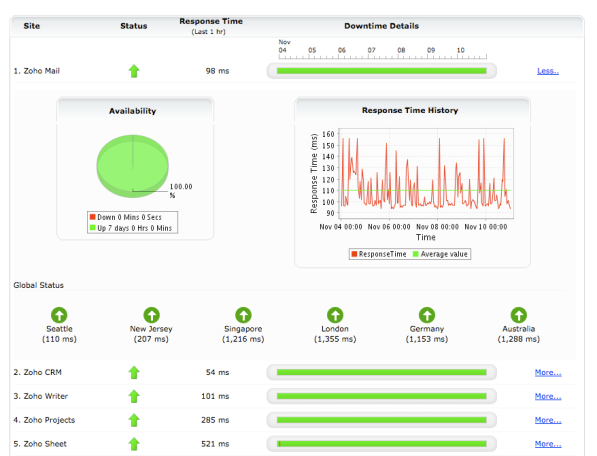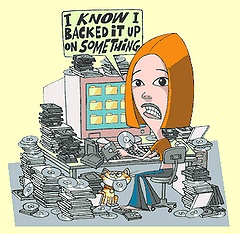No service is a 100% available, and of course your SaaS provider’s outage always comes in the ‘worst time’, just when you have a deadline to meet… what really gets painful is when you have no information whatsoever on what just happened and how long the outage may be. Major providers like Salesforce.com and Amazon learned the lesson the hard way, and they both released their status dashboards after extended outages and the customer uproar that followed:
Free services rarely display such level of transparency, but that’s exactly what Zoho is announcing today: they created Zoho Status , a monitoring service which displays the health of all Zoho Applications – currently 24. Here’s a partial screen-print:

 If it looks familiar, perhaps you followed my earlier advice on using Zoho’s Site24×7 service on your own site or even blog. I’ve been using it for two years now, and received alerts of outages that neither I nor my service provider were aware of.
If it looks familiar, perhaps you followed my earlier advice on using Zoho’s Site24×7 service on your own site or even blog. I’ve been using it for two years now, and received alerts of outages that neither I nor my service provider were aware of.
Zoho took their own tools and turned it into a public availability display, monitoring their services from six different locations: Seattle, New Jersey, Singapore, London, Germany and Australia. For now the display is rather “boring”, being all green. Obviously we’re all better off if it stays that way and we have no reason to check the status site.
What makes sense, however, is to use Site24×7 on your own site, or on any service you are dependent on (you don’t have to install anything, it’s all external monitoring). As usual, it starts with a free level, adding extra paid services – the new addition today is the Enterprise version, allowing SLA definition, compliance tracking and reporting.
Related articles:
- Questions To Ask Before Trusting a Cloud Vendor
- Zoho Redefines Transparency With Zoho Status
- Zoho and the Cloud Stability Question
- Transparency is catching: Zoho shows status
- Zoho Status – Powered by Site24×7
(This article is cross-posted from for CloudAve, the Zoho-sponsored Cloud-Computing / SaaS / Business Blog I am editing. Subscribe to our feed here.)


 Ben recently reported on how
Ben recently reported on how 

![Reblog this post [with Zemanta]](https://www.zoliblog.com/wp-content/uploads/HLIC/54e6a3db43b098ecbf5db09e027cb1c1.png)

![Reblog this post [with Zemanta]](https://www.zoliblog.com/wp-content/uploads/HLIC/1e888c58c2f8097a76d183db620f05dd.png)
 I don’t claim to be an expert economist, so
I don’t claim to be an expert economist, so  )
) On my personal blog I don’t have to be as politically correct as on CloudAve, so here’s my summary: they tried SaaS, could not crack it, so concluded the market as a whole did not matter – a strategic mistake.. or… well, as they say, a
On my personal blog I don’t have to be as politically correct as on CloudAve, so here’s my summary: they tried SaaS, could not crack it, so concluded the market as a whole did not matter – a strategic mistake.. or… well, as they say, a  We can argue all we want about the benefits of SaaS, discuss hypothetical use cases at length, but the best showcases are served up by real life, often unexpectedly.
We can argue all we want about the benefits of SaaS, discuss hypothetical use cases at length, but the best showcases are served up by real life, often unexpectedly.  see the benefits of a
see the benefits of a 
Recent Comments